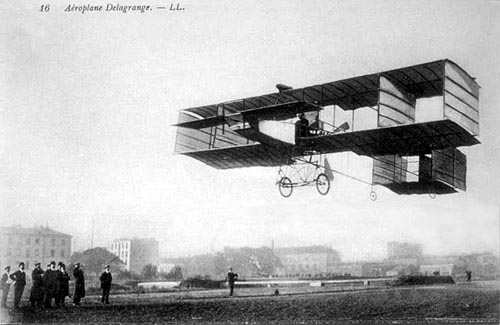Charles and Gabriel Voisin were France’s answer to the Wright Brothers. In 1904, they established a factory for the production of gliders and experimental machines, designing primitive biplanes in 1906. Having constructed a power machine for Leon Delagrange, Charles Voisin made his first power flight in it, a short hop of 10 meters, at Bagatelle on March 16, 1907. The machine was a biplane pusher, biplane elevator forward on outriggers, box tail aft on outriggers, rudder inside tail and Antoinette 50 h.p. engine. Over the next two months, the machine flew distances of 20m, 60m, 50, and 34m. It was delivered to Delagrange in April(?), but he did not fly it until later.
[ad#ad-1]On November 5, 1907: First flight by Leon Delagrange, at Issy where, on November 5, 1907, Delagrange himself flew 100m.
The Voisins delivered the Delagrange II, similar to the previous craft, that winter.
January 20, 1908—With the Delagrange II, similar to the previous one, with Antoinette 50 h.p. engine, Delagrange flew 100m. In March of 1908, he made more flights of 300m, 500m, 600m, and on March 20, competing with Henri Farman, he made a circle of about 700m. The next day, he took Farnam aloft, making him the first passenger to fly in an airplane. Delagrange continued to fly longer distances:1,500m, 2,500m, and 3,925m in 6:30.
In April of 1908, Parisians had the opportunity to enjoy the daily spectacle of Henry Farman and Leon Delagrange, in their twin flying machines. They were out every morning and afternoon, weather permitting, sometimes for hours at a time, flying around the grounds at Issy with remarkable ease and skill for the time. Almost daily they flew tow or three miles. The sight of the two machines in the air at the same time, zipping along at the speed of a train thrilled the spectators. On sunny afternoons tourists from all over the world – Americans, Germans, Chinese, Japanese, English, and even Africans – assembled along one side of the open military maneuver grounds, following the fliers with great interest and cheering any unusual feature.
The 3,935 meter flight set a world distance and duration record, beating Farman’s earlier marks.
He moved on to giving flight exhibitions in Rome. On May 23-31, he made numerous flights up to 8 kilometers.
On May 30, he impressed the Italian spectators by staying aloft for 15 minutes and 30 seconds, only coming down because he received a signal to do so, and because his airplane could not hold enough gasoline to operate for much longer than that. During that time, Delagrange made over nine rounds over an established course, covering sixteen kilometers (10 miles), flying at a speed of 60 km (37.2 miles) per hour.
Practically every day from 8 o’clock in the morning until 8 in the evening, the wind would blow too strongly, so on May 30, the flight trial occurred at 5 o’clock, in front of fifteen dedicated lovers of aviation. It was very calm and not a leaf moved, nor the flags marking the course.
Delagrange’s assistants pushed the plane forward, and as soon as the engine started, the Voisin-built craft rose without difficulty, keeping from seven to ten feet above the ground. It moved smoothly and turned easily, the rounds of the course following each other without interruption, and not once did the airplane touch the ground. It was a marvelous performance and would have won Delagrange the prize of $5,000 had it occurred in France. Later that same day, Delagrange attempted another flight before the French ambassador, but the wind was blowing and he could not proceed.
Delagrange set new world DURATION AND DISTANCE RECORDS of 17 km. in 18:30 (June 23). He then took his flying machine to Turin in late June, and on July 8 he took up Mme. Therese Peltier, FIRST WOMAN TO FLY IN AIRPLANE. Back in France, on September 5 he flew 10 km. in 9:40 with a new Antoinette 50-60 h.p. engine. (I believe these flights were all made in the Delagrange II, but am not certain.)
Delagrange’s flights continued. In August 1909 he flew a Voisin and a Bleriot at Rheims meet in which Curtiss represented America. He had become one of the greatest aviators of his time and flew in a number of meets, before being killed in an airplane crash in 1910.
